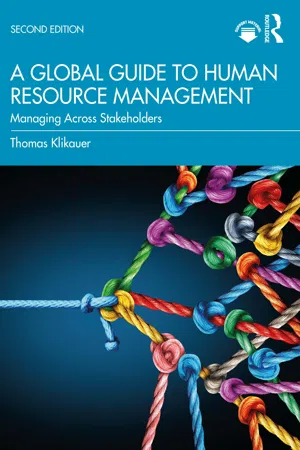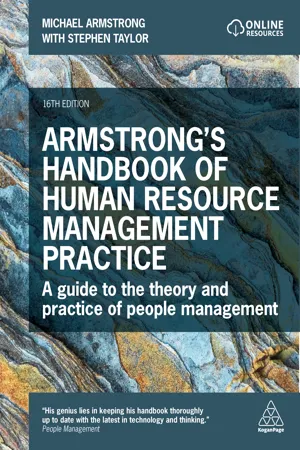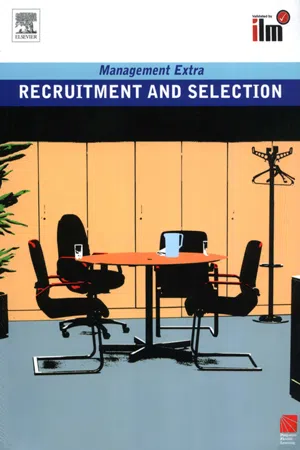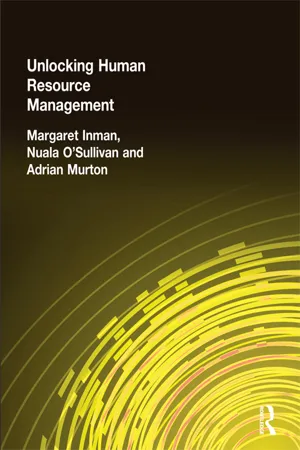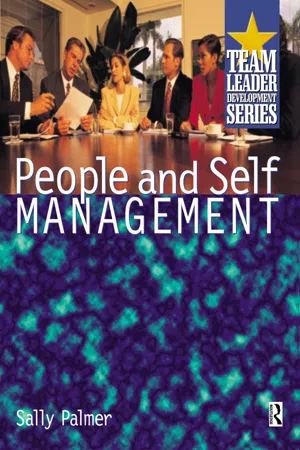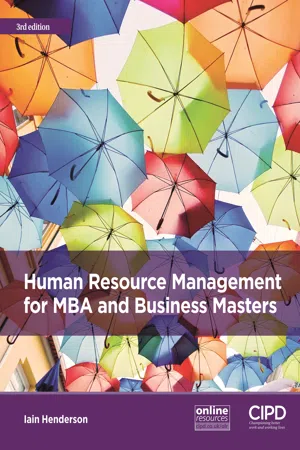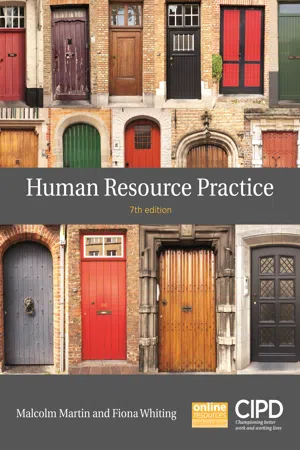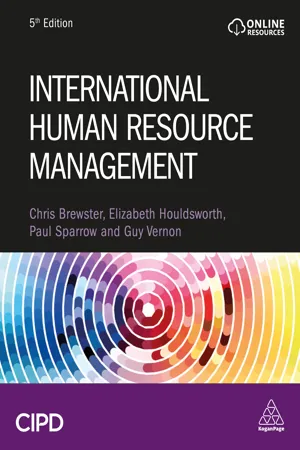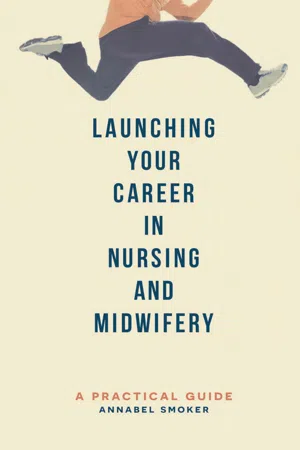Business
Recruitment And Selection
Recruitment and selection refer to the process of identifying, attracting, and appointing suitable candidates for job vacancies within an organization. Recruitment involves sourcing and attracting potential candidates, while selection involves assessing and choosing the most qualified individuals for the job. These processes are crucial for ensuring that the right talent is brought into the organization to meet its staffing needs.
Written by Perlego with AI-assistance
Related key terms
Related key terms
1 of 4
Related key terms
1 of 3
11 Key excerpts on "Recruitment And Selection"
- eBook - ePub
Strategic People Management and Development
Theory and Practice
- Gary Rees, Ray French, Gary Rees, Raymond French(Authors)
- 2022(Publication Date)
- CIPD - Kogan Page(Publisher)
Recruitment And Selection are often presented as a planned rational activity, comprising certain sequentially linked phases within a process of employee resourcing, which itself may be located within a wider HR management strategy. The two terms are commonly differentiated although there is a clear link between them.Recruitment is commonly understood as a process by which a pool of capable people is generated, who then apply for employment in an organisation. Selection is the process by which managers and others identify and use valid instruments enabling them to choose potentially effective future employees from a pool of applicants. When selecting employees, those responsible will need to act in the light of given management goals within the organisation and, of course, the legal requirements in place within a specific country and any relevant pan-national institutions.Recruitment And Selection are interlinked; however, each element can require specific skills and expertise, and may therefore be best carried out by different people. It is not uncommon for the recruitment activity – although not normally the selection decision itself – to be outsourced, for example, to an agency. It is useful to treat each activity separately (see also Hook and Jenkins, 2019).Recruitment And Selection, as defined here, can play a pivotally important role in shaping an organisation’s effectiveness and performance, if work organisations are able to acquire workers who already possess relevant knowledge, skills and aptitudes and can make an accurate prediction regarding their future abilities. If we accept this premise (which will be questioned to some extent in this chapter), then recruiting and selecting staff in an effective manner can both avoid undesirable costs – for example, those associated with high staff turnover, poor performance and dissatisfied customers – and engender a mutually beneficial employment relationship characterised, wherever possible, by high commitment on both sides.Recruitment And Selection is a topical area. While it has always had the capacity to form a key part of the process of managing people as a routine part of organisational life, it is suggested here that Recruitment And Selection has become ever more important as organisations increasingly regard their workforce as a source of competitive advantage. Of course, not all employers engage with this proposition even at the rhetorical level. However, there is evidence of heightened interest in the utilisation of employee selection methods which are valid, reliable and fair. For example, the search for rigorous application and scrutiny of employee selection procedures has seen insights derived from work psychology have increasingly significant influence on the way people are recruited into work roles. (Arnold et al, 2020). In this chapter we will examine several contemporary themes in Recruitment And Selection including the so-called competency approach and online recruitment. - eBook - ePub
A Global Guide to Human Resource Management
Managing Across Stakeholders
- Thomas Klikauer(Author)
- 2022(Publication Date)
- Routledge(Publisher)
2 Getting the Right People Recruitment And SelectionDOI: 10.4324/9781003293637-2Executive Summary
Recruitment And Selection is the process through which companies hire people. It is divided into two parts: (1) recruitment that establishes a pool of suitable candidates and (2) selection which is the process of selecting the right candidate from this pool. The pool of candidates should have the right number of people with the right skills who are likely to accept the position. Recruitment And Selection should be underscored by a formal HR policy. This demands that recruiters engage with the labour market that is different from, for example, the commodity market. Recruiters use different strategies to advertise positions while looking for a few basic overall characteristics in future employees. The selection process starts when recruiters establish a short list of candidates and conduct interviews which are followed by reference checking and additional testing. Once this is completed, HR recruiters can offer the position to the potential candidates. The Recruitment And Selection process ends when a position is offered and accepted and the candidate participates in an induction programme.Key Learning Objectives
- Realise the importance of recruiting talent for business success;
- Identify the difference between “recruitment” and “selection”;
- Outline the recruitment strategies a company can use to fill job vacancies;
- Describe the key elements of the Recruitment And Selection process;
- Explain the role of recruiters in the recruitment process;
- Understand the preferred methods used in selecting human resources;
- Show an awareness of how culture can influence the recruitment process;
- Ascertain key fallacies in recruiting and selecting; and
- Develop a formal HR policy on Recruitment And Selection.
Recruitment
For most people, working life starts with being recruited to work for a company, a firm, or a corporation. At its most basic level, a company is an organisational structure set up as a legal entity for the economic purpose of achieving profit maximisation. At a larger level, corporations are owned and controlled by shareholders and each of their shares creates ownership in the corporation.1 Control over a corporation and its profits is determined by the portion of shares owned in the company. One of the crucial legal decisions on corporations came with “Dodge vs. Ford Motor Company”2 - eBook - ePub
Armstrong's Handbook of Human Resource Management Practice
A Guide to the Theory and Practice of People Management
- Michael Armstrong, Stephen Taylor(Authors)
- 2023(Publication Date)
- Kogan Page(Publisher)
27Recruitment And Selection
Introduction
This chapter starts with an overview of the Recruitment And Selection process and of how it is planned and progressed. It then deals in turn with:- Defining requirements
- Attracting applicants
- Sourcing candidates: digital and traditional approaches
- Screening applications
- Selection methods
- Interviewing
- Testing
- Assessment centres
- Assessing candidates
- Completing the process
The Recruitment And Selection process
Recruitment is the process of finding and engaging the people the organization needs. Selection is that part of the recruitment process concerned with deciding which applicants or candidates should be appointed to jobs.The aim of Recruitment And Selection is to find suitable candidates to fill vacancies and then predict the extent to which they will be able to carry out a role successfully. It involves deciding on the degree to which the characteristics of applicants in terms of their competencies, experience, qualifications, education and training match a person specification.It is not easy to get it right. According to Groysberg et al (2009), usually about a third of promising new hires leave within three years of being recruited. And it can be costly, especially for senior staff. The 2020 CIPD survey of resourcing and talent planning found that the average recruitment cost of filling a vacancy for a director or senior manager was £5,000, while for other employees it was £2,000.Recruitment And Selection programmes can be complex and careful planning is necessary. There is always a choice between different sources of candidates, the use of digital or other technologies rather than traditional methods, the use of interviews, tests or assessment centres, and the type of interview (face-to-face, telephone or video) and the type of test.The process may start with a workforce plan from which detailed recruitment plans are derived. But requirements more commonly emerge on an ad hoc basis because of the creation of new posts, expansion into new activities or areas, or the need for a replacement. These short-term demands often put HR under pressure to deliver candidates quickly. - eBook - ePub
- Elearn(Author)
- 2009(Publication Date)
- Routledge(Publisher)
Essentials of Recruitment And Selection Let's start by making a distinction between selection practices and recruitment strategies.Recruitment is best described as the way in which an organisation tries to source or attract the people from whom it will ultimately make selections. Recruitment strategies include efforts to reach better pools of candidates and to sell the organisation as an employer of choice.Selection is about choosing between job candidates. It is about how to make a fair and accurate assessment of the strengths and weaknesses of applicants and how to identify the candidate who is most likely to perform well in the job.The purpose of selection is to match people to work. It is the most important element in any organisation's management of people simply because it is not possible to optimise the effectiveness of human resources, by whatever method, if there is a less than adequate match.Roberts (1997)It's also important to note that external recruitment is only one option for solving resource shortfalls in your organisation. Most organisations now deploy a variety of flexible working practices and HR planning techniques to help match the supply of people to peaks and trough in demand.In this first theme, you will:♦ Identify the main stages in the Recruitment And Selection process and consider the central role of the line manager♦ Analyse the strengths and weaknesses of the Recruitment And Selection process in your organisation♦ Assess how the legal framework for Recruitment And Selection supports the promotion of equal opportunities and a diverse workforce♦ Explore alternatives to external recruitment for addressing shortfalls in an organisation's pool of skills, knowledge and experienceThe Recruitment And Selection process
Getting it wrong is not an option - if the wrong person is appointed it can affect teamwork, while morale and motivation take a nosedive. Your productivity goes down and there are sharp questions that must be answered - probably by you. - eBook - ePub
- Margaret Inman(Author)
- 2014(Publication Date)
- Routledge(Publisher)
Recruitment And Selection should also be a two-way process. It is just as important for the candidate to get to know the company and see if they really want the job as it is for the company to discover if the prospective employee suits the business needs. Sadly some companies don’t realise this and I’m sure you may have experienced both good and bad Recruitment And Selection procedures. However, the best companies do realise the importance of this two-way process.An example of good Recruitment And Selection is Microsoft, who have so many applications for each role they give plenty of information early on so that people can see if the job will suit them. The British Army do the same. If you go on their website www.armyjobs.mod.uk you can take an assessment and participate in ‘virtual training’ to see if the army would be the right career for you before you even look at the application procedure.So far the terms ‘recruitment’ and ‘selection’ have been used together, but they are in fact distinct in that they involve different activities. Recruitment is the part of the process concerned with finding applicants. It requires positive action by employers to sell themselves in the relevant labour market to generate interest and applications of suitably qualified candidates. Selection is that part of the process that involves choosing between applicants and identifying who would be the most suitable for the job on offer and rejecting the rest.KEY TERMSRecruitment The process used to attract candidates.Selection Choosing between applicants and identifying who would be most suitable for the job.The time, cost and importance of each stage depends on the state of the labour market. When the economy is buoyant and the labour market is tight, recruitment activities become very important, companies have to work harder in finding potential suitable employees. Conversely when the economy takes a downturn and jobs are in short supply, there is usually little shortage in suitable applicants. This means that more attention is given to the selection stage as organisations focus on ways to correctly differentiate between suitable candidates. Many companies who were struggling to find suitable applicants in 2007 were overwhelmed by the increase in number and quality of applicants for posts advertised in 2009 when the world economy was in recession. For instance, John Lewis had 250 people chasing each of its graduate jobs in 2009 which is an increase of 87 per cent from 2008. Microsoft had 5,000 applications for 25 vacancies and Tesco applications were up 50 per cent in 2009. - eBook - ePub
- Sally Palmer(Author)
- 2007(Publication Date)
- Routledge(Publisher)
Recruitment is the process of attracting sufficient numbers of people to apply for jobs in the organization. The aim of recruitment is to ensure that your organization has the right kind of people, and that the organization's demand for human resources is met, by attracting the right type of potential employees in a cost effective and timely manner.The process of selection is about selecting the most suitable people, who have been attracted by the recruitment process, to work in the organization. The aim of selection is to identify, from those coming forward from the recruitment process, the individuals most likely to meet the needs of the organization. See Figure 4.1 for an overview of the Recruitment And Selection process.Figure 4.1An overview of the Recruitment And Selection processA study of this chapter will not make you an expert on human resource planning or on Recruitment And Selection. Human resource planning is usually carried out by senior managers. Recruitment is usually carried out by personnel specialists within the organization but the selection process is usually carried out across the organization. This chapter concentrates on dealing with the aspects of the process which you, as a first line manager, might be involved in. For example, you might be required to assist with the selection process in order to fill a job vacancy.In this chapter we start by looking at the importance of human resource planning followed by a brief mention of the legislation that you need to be aware of if you are involved in the Recruitment And Selection process. The chapter then gives an overview of the Recruitment And Selection process before examining each aspect of the process in more detail.Whether or not you are involved in the selection of new staff, from outside the organization, you will be involved in selecting people from your existing team for various tasks such as: to join a particular group, for secondment to a special project or to be moved into a different job role, possibly for promotion. Sometimes you will be consulted by your manager about selecting staff from amongst your team, sometimes you will have to make a selection yourself. - eBook - ePub
Human Resource Management and Change
A Practising Manager's Guide
- Lanny Entrekin, Brenda D. Scott-Ladd(Authors)
- 2013(Publication Date)
- Routledge(Publisher)
8 Recruitment And Selection DOI: 10.4324/9780203684016-8Historically, although HRM and personnel were middle-level functions, they still had responsibility for staffing companies. This reflected the lack of importance that was attached to this critical function between the 1940s and the 1970s.Essentially, Recruitment And Selection are the opposite extremes of the same process. It follows, therefore, that the quality of selected applicants can be no better than the quality of the pool of candidates who are presented for the selection process. The purpose and importance of recruitment are reflected in the following points. Recruitment makes it possible for the firm to:- determine its present and future staff needs in conjunction with HR planning and work/job analysis;
- increase the pool of job applicants at minimum cost;
- increase the success rate of the selection process by reducing the number of obviously under-qualified or over-qualified job applicants;
- reduce the probability that new hires will leave the organization after only a short period of time;
- meet its responsibility for equal opportunity programmes and other social obligations regarding the composition of the workforce;
- evaluate the effectiveness of various techniques and services for sourcing job applicants.
Unlike the previous era, current labour conditions are varied and volatile. Despite the downturn caused by the global financial crisis, there are widespread skill shortages in the developed world. For example, Microsoft expects that Cloud technology-related jobs will grow to 7 million by 2015, and estimates that in 2012 an existing 1.7 million positions related to the technology could not be filled because of insufficient numbers of trained and accredited staff (Microsoft.com , 2012). Before the current financial crisis, many developed countries were struggling to fill professional positions, and even with the current downturn, this is still a problem in areas like health care, education and engineering. In 2008, Australian company Worklife Solutions estimated that 50 per cent of staff turn over every two years, one in four leaves within six months of being recruited, and 70 per cent of companies report turnover has a negative effect (Roth, 2008 - Iain Henderson(Author)
- 2017(Publication Date)
- CIPD - Kogan Page(Publisher)
et al (1984, p66) termed ‘managing the human resource flow’: ‘The more dynamic the environment . . . the more a corporation must be concerned with managing the flow of people in, through and out of the organisation.’For the twenty-first century we can update this to say ‘managing and developing the human resource flow’. Table 2.1 illustrates the key stages in this process.Table 2.1 Managing and developing the human resource flowStrategic levelIndividual job/ person levelActions/outcomesTalent management for high-value (core) staff Organisational development Human resource planning Job analysis Identifying the task requirements and criteria for job success Person specification Identifying the attributes and experience the job-holder needs to achieve job success Recruiting Attracting applicants for consideration for the position Initial screening Examining applications to identify those most suitable for further consideration Selection Interviews, testing and obtaining other information to assess applicants’ attributes Initial induction and training Induction to the organisation. If necessary, additional testing, assessment and training to fit the person for the job - eBook - ePub
- Malcolm Martin, Fiona Whiting(Authors)
- 2016(Publication Date)
- CIPD - Kogan Page(Publisher)
Figure 5.1 ).5.9 THE SELECTION PROCESS
At this stage, before looking at selection methods and processes used by appointing managers, it is worth mentioning the range of initial selection processes that may be carried out before the candidate ever gets to meet anyone from the company. Some companies, such as Tesco, have online applications that include a requirement for candidates to respond to different customer service scenarios, the responses then being used to support shortlisting. Online job sites, employment/recruitment agencies and headhunters also use a range of techniques to assess candidates before submitting a list of matched candidates to the organisation looking to recruit.Once you have your range of applicants, either by direct response to your company or via a job site/recruitment agency, you should make your decision on the successful candidate as a result of:- candidate data collection
- candidate assessment
- comparison.
You should always avoid making a simple comparison of candidates with each other because this is likely to be highly subjective and will lead to an offer of the position to the candidate who was deemed to be ‘the best on the day’. Instead, you should use the person specification and, at each stage, compare the candidates with the essential and desirable requirements listed. Bad selection decisions can be very costly, and it is always better to make no appointment than the wrong appointment. - eBook - ePub
- Christopher Brewster, Elizabeth Houldsworth, Paul Sparrow, Guy Vernon(Authors)
- 2023(Publication Date)
- CIPD - Kogan Page(Publisher)
They lie in the perceived irrelevance of the assessment process and the impact on motivation. There is also the problem of fairness. Candidates to whom inappropriate testing has been applied can find that they do not progress as well through internal selection systems. Such discrimination is equally inappropriate. Countries also differ greatly in terms of the practices related to user qualification, legal and statutory constraints on test use and the consequences for those tested, and controls exercised over the use of tests. Recruitment in its institutional context Having outlined the main tools and techniques available, we now place recruitment activity into an institutional context. It is difficult to separate Recruitment And Selection activity from the potential knock-on effects that they have on other areas of HRM, including overall skill levels, training and development needs, employee retention, trade union membership and employee relations, diversity management, and pay and benefits (Wood and Szamosi, 2016). In an international perspective, the academic literature has turned away from comparative studies on specific Recruitment And Selection practices towards an attempt to better place such practices in their broader institutional context (Wood et al, 2014). These analyses draw attention to the potential for uneven regulatory enforcement. They link the existence of models of high-volume and low-rigour recruitment, or more authoritarian and patriarchal systems in which weak employee voice and rights are considered to be offset by informal ties and implicit understandings, to the institutional context. They argue that, in institutional contexts where there is more intense labour market regulation that discourages organisations from shedding staff, the Recruitment And Selection process is vested with a great deal of importance - eBook - ePub
Launching Your Career in Nursing and Midwifery
A Practical Guide
- Annabel Smoker(Author)
- 2015(Publication Date)
- Bloomsbury Academic(Publisher)
4 The Selection and Recruitment Process KEY WORDSJob description; Agenda for Change; Knowledge and skills Framework (KSF); NHS Constitution; Values-based recruitment; Minimum genuine occupational qualifications (GOQ); Screening; Shortlisting; Social networking and lifestyle; selection; requirements; Methods; Purpose of interviews; Types of interviews; Assessment centres; On-the-spot screening interviews; Assessment centres; Panel interviews; Classic one-to-one interviews; Multiple mini-interviews (MMIS); Telephone or webcam-based interviews; Presentations; Group interviews; Competency-based assessment; Role play and simulation; Numeracy and literacy assessments; Psychometric and aptitude tests; Equality Act; DiscriminationThis section offers a unique insight into the employer’s perspective in order for you to understand the process which underpins Recruitment And Selection. It will start by looking at how the formal pay and progression structure is used in conjunction with policy to create the job description. It will then examine values-based recruitment (VBR) and the emergent role of service users in recruitment processes. Consideration will be given to how employers will screen applications to produce a shortlist before reviewing the different ways of thereafter selecting the ideal candidate. The final section deals with the law pertaining to applications, interview conduct, disability and health and employment checks. There is also specific advice for overseas registrants wishing to work in the UK.THE JOB DESCRIPTIONThe job description and associated salary must comply with specific requirements relating to pay and conditions and legislation. In the NHS pay scales are agreed nationally on an annual basis. An independent healthcare provider can choose to mirror the public sector pay scale, with or without additional employee benefits. Understanding how pay and pay progression are determined is an important part of your transition into qualified employment and beyond. Agenda for Change (AfC) (DH 2004) was introduced to provide a clear definition of the level of knowledge and skills required for each post. It modernised the pay and conditions for both nurses and midwives. A newly qualified practitioner will enter at Band 5 and there will be an outline set of competencies, known as the Knowledge and Skills Framework (KSF), for this role. There are six core dimensions present in every job outline (Box 4.1) and then 2–6 specific dimensions taken from a comprehensive list of 24. Within each dimension there are four levels; the higher the level, the higher the level of skill and knowledge required to fulfil the post (RCN 2014b).
Index pages curate the most relevant extracts from our library of academic textbooks. They’ve been created using an in-house natural language model (NLM), each adding context and meaning to key research topics.
Explore more topic indexes
Explore more topic indexes
1 of 6
Explore more topic indexes
1 of 4

